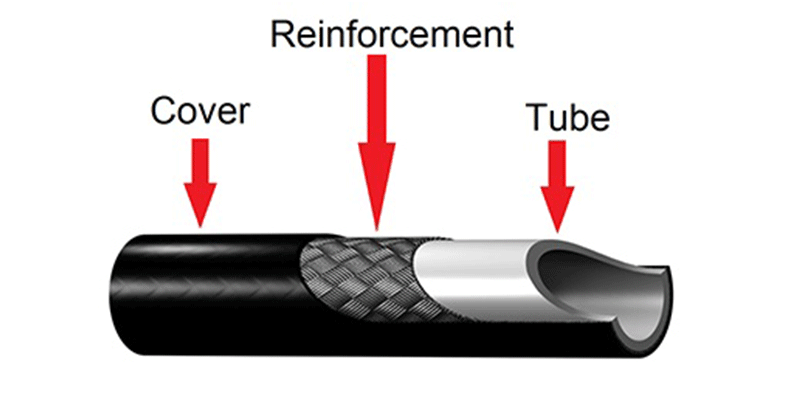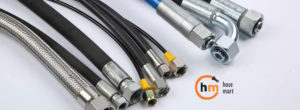A hydraulic hose is a high-pressure tube designed to carry hydraulic fluid to transmit force within hydraulic machinery. These hoses are a critical component in hydraulic systems that are commonly used in various industries for transmitting power between hydraulic components, such as pumps, actuators, and hydraulic cylinders.
Hydraulic hoses play a crucial role in facilitating the movement of hydraulic fluids under high pressure to accomplish various tasks in machinery and equipment.
Construction:
- Inner Tube: The inner tube is the core of the hydraulic hose and is designed to withstand the hydraulic pressure and convey the hydraulic fluid. It is commonly made of synthetic rubber or thermoplastics.
- Reinforcement Layer: Surrounding the inner tube is the reinforcement layer, typically made of one or more layers of braided steel wire or spiral-wound wire. This layer provides strength and flexibility to the hose.
- Outer Cover: The outer cover protects the hose from external damage, such as abrasion, chemicals, and environmental factors. It is usually made of a synthetic rubber compound.

Types of Hydraulic Hoses:
- Low-Pressure Hydraulic Hose: Used for low-pressure hydraulic applications.
- Medium-Pressure Hydraulic Hose: Suitable for applications with moderate hydraulic pressures.
- High-Pressure Hydraulic Hose: Designed to handle high-pressure hydraulic systems, such as those in heavy machinery and construction equipment.
- Very High-Pressure Hydraulic Hose: Used in extreme pressure applications.
End Connections:
- Hydraulic hoses have different end fittings or connectors to attach to various components within a hydraulic system. Common end connections include threaded connections, flanges, quick-connect fittings, and more.
Flexibility:
- Hydraulic hoses need to be flexible to accommodate the movement of hydraulic components. The construction of the hose and its materials contribute to its flexibility while maintaining structural integrity.
Bend Radius
Fluid & Flow Rate
Fluid Compatibility:
- Hydraulic hoses are designed to be compatible with specific hydraulic fluids, including oil-based fluids, water, synthetic hydraulic fluids, and more. It’s crucial to use the correct type of hose for the specific hydraulic fluid in use.
Size and Diameter:
- Hydraulic hoses come in various sizes and diameters to suit different applications. The size and diameter are chosen based on factors such as flow rate, pressure requirements, and space constraints.
Temperature Range:
- Hydraulic hoses are designed to operate within specific temperature ranges. It’s important to select a hose that can withstand the temperatures present in the hydraulic system.
Size & Mesurements
Temperature Range
Installation and Maintenance:
- Proper installation and regular maintenance are crucial for the performance and longevity of hydraulic hoses. This includes checking for leaks, inspecting hose conditions, and ensuring that hoses are not bent beyond their recommended bend radius.
Hydraulic hoses are fundamental components in hydraulic systems, enabling the transfer of power and control in various industrial applications, including agriculture, construction, manufacturing, and more. Proper selection, installation, and maintenance are essential to ensure the reliable and safe operation of hydraulic systems.


